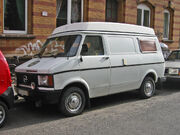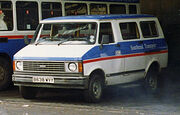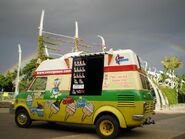 | |
| Manufacturer | Bedford Vehicles |
|---|---|
| Parent company | General Motors Europe |
| Also called | Bedford Blitz |
| Production | 1969–1988 |
| Predecessor | Bedford CA |
| Class | Light commercial vehicle |
| Body style(s) | Van |
| Layout | Longitudinal front engine, rear-wheel drive |
| Engine(s) |
Slant Four: 1.6 1.8 2.0 2.25 2.3 |
| Transmission(s) |
3-speed manual 4-speed manual 5-speed manual 3-speed automatic |
| Wheelbase | 106–140 impin (2,692–3,556 mm) |
| Related | Bedford Dormobile |
The Bedford CF was a model of light commercial vehicle produced by Bedford Vehicles for almost twenty years from the late 1960s. In Germany and certain other continental markets, the CF was sold through Opel dealers as the Bedford Blitz from 1973 on.
CF[]

(late) German market Bedford Blitz, note 'Opel' logotype
Introduced early during November 1969,[1] the CF van variants were some of the most popular light commercial vehicles on British roads.
The CF could be specified with a sliding door in the side panel directly behind the passenger door,[1] and it was generally with this layout that the van was also commonly used as a base vehicle for a caravanette.[2]
The engine was the well-proven Slant Four engine which was introduced for the Vauxhall FD Victor models in 1967. Apart from an increased engine capacity from 1.6 l (1,598 cc) to 1.8 l (1,759 cc) units and from 2.0 l (1,975 cc) to 2.3 l (2,279 cc) in 1972, the power units remained unchanged. A four cylinder 1.8 l (1,760 cc) Perkins diesel engine could be specified for an extra GB£130 (1969),[1] while a larger 2.5 l (2,523 cc) version was used for heavier versions. In 1977, a 2.1 l (2,064 cc) OHC diesel engine from Opel replaced the outdated Perkins units.
In Australasian markets, the CF could be optioned with Holden six-cylinder units, in 2,850 cc (173.9 cu in) and 3,310 cc (202.0 cu in) forms. This was as an answer to the rival Ford Transit range, which in Australia used six-cylinder engines from the Ford Falcon range.
The Bedford used the same basic suspension lay-out as the Vauxhall Victor, though married to greater wheel arch clearances and calibrated for greater weight carrying capacity.[3] The front independent suspension featured a double wishbone layout with coil springs and telescopic shock absorbers, while the rear wheels were suspended by a combination involving a live axle and traditional long single-leaf springs.[1]
Several different manual transmissions were used, namely the Vauxhall three-speed, four-speed, Bedford four-speed, ZF four-speed, ZF five-speed, and the General Motors automatic. The Laycock type of overdrive was available to order or on the later Vauxhall four-speed models.[2]
There were three CF1 body styles. A standard panel van which was intended to rival the Ford Transit; the special van body (essentially a self-contained cab with a general-purpose chassis onto which a wide range of custom-built bodies or beds could be built), and the Dormobile (caravanette). The Automatic gearbox was a three speed. This made a very nippy SWB Delivery Van in 2.3-litre form.
CF2[]

1985 CF series 2
The CF series 1 facelift was introduced in 1980, introducing the 2.3 L (2,260 cc) Opel 23D diesel engine with 61 hp (45.5 kW).[4] Units exported to Germany (Bedford Blitz) received a smaller, 2.0 L (1,998 cc) diesel, producing 60 PS (44 kW/59 hp).[5] The 1.8 and 2.3 litre petrol units remained the same. The CF2 then followed in 1984, with different engine and transmission options. While the diesel engines remained the 2.3 (with the 2.0 available in continental Europe), the old Vauxhall slant fours were replaced by a 2.0 L (1,979 cc), 78 hp (58 kW) version of General Motors' corporate cam-in-head four cylinder.[4] The CF2 and facelift series 1 differed in looks slightly from the CF1, being squarer and having a plastic single piece grill. Dormobile models had a unique body shape.
Commercial[]
The Bedford CF van was the second most popular van in the UK, second only to the Ford Transit. Along with the Transit, the CF was usefully wider than competitor vehicles from Austin-Morris, Rootes and Volkswagen.[6] It was also the most common caravanette. CFs were popular with customisers throughout the 70s and 80s.
Users[]
Like the modern-day Ford Transit, the Bedford CF was widely used. The British police, in particular, used them for prisoner transport and as riot vans. The British Military also had a very large fleet of CFs. They were very much favored by builders and builders' merchants. Courier services and the Post Office used them. They were also a popular caravanette due to their space and reasonable fuel consumption. They were and still are very widely used as ice cream vans in Britain.[2]
Technical specifications[]
Source[2]
| model | engine displacement | designation | wheelbase |
| 14/18 cwt | 1,599 cc / 1,759 cc | 97100 | 106 in (2,692 mm) |
| 22 cwt | 1,975 cc / 2,279 cc | 97300 | 106 in (2,692 mm) |
| 25 cwt | 1,975 cc / 2,279 cc | 97500 | 126 in (3,200 mm) |
| 35 cwt | 1,975cc / 2,279 cc | 97700 | 126 in (3,200 mm) |
| 35 cwt (code 350) | 2,279 cc | 97700 | 140 in (3,556 mm) |
References[]
- ↑ 1.0 1.1 1.2 1.3 Charles Bulmer (Ed) (8 November 1969), "New Bedford Motor caravans [planned]", Motor (nbr 3516): page48.
- ↑ 2.0 2.1 2.2 2.3 Haynes Owners workshop manual Bedford CF van
- ↑ "Taxi!:Autproject 3 [for the design of a Bedford based taxi)", Autocar. 134 nbr 3923: 10–12. date 3 June 1971.
- ↑ 4.0 4.1 Bedford CF2: Specifications and Dimensions. Luton, UK: Bedford Commercial Vehicles. 1984. p. 2. B2147/4/84, http://www.bedfordcf.co.uk/br/br26_p1.jpg. Retrieved on .
- ↑ Bedford Blitz Kastenwagen (catalogue). Rüsselsheim, Germany: Adam Opel AG. September 1979. p. 12. 90014 (979/30/1), http://www.bedfordcf.co.uk/br/br54_p11.jpg. Retrieved on .
- ↑ Maurice Smith (19 November 1977), "Can a van ... serve as a ...second car...?...."Sherpa, Hi-Ace, VW you ask? - These of course have their merits and their extra economy but they also have one or more shortcomings for our intended use. In particular there is a minimum width and internal capacity for transverse beds plus the main items of equipment we require, and these three vehicles fall short. We require a refrigerator and do not wish to cook or wash [dirty dishes] outside the van."", Autocar. 147 (nbr 4228): pages 61–62.
External links[]
| This page uses some content from Wikipedia. The original article was at Bedford CF. The list of authors can be seen in the page history. As with Tractor & Construction Plant Wiki, the text of Wikipedia is available under the Creative Commons by Attribution License and/or GNU Free Documentation License. Please check page history for when the original article was copied to Wikia |
- CF-UK: The Bedford CF Web Site - CF enthusiasts' website
- Video clips
- Images

